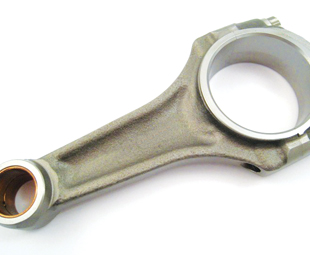The secret life of a conrod

An engine’s hardest working parts are the connecting rods that join its pistons and crankshaft. JAKE VENTER explores their role and functions.
One normally thinks of an engine as a machine that rotates, but the pistons only move up and down. And that’s not all! To borrow a popular phrase from TV advertisements, they also come to a complete stop twice per revolution; and then move in the opposite direction.
Piston movement is controlled by the con rods, whose top parts move up and down – dragging the pistons with them – while their bottom parts rotate with the crankshaft. Together with the twice-per-revolution stopping, this complex combination of movements ensures that each item is stressed to a degree that is virtually incomprehensible.
The piston’s distance from top-dead-centre (TDC), as well as its speed and acceleration, can be calculated; and the results show that these parts accelerate twice per revolution – more than a hundred times faster than the speediest dragster!
To appreciate this, I’m going to ask you to accompany me on a journey inside an engine. Let’s assume we’re small as ants, clothed in special suits that enable us to withstand pressures and temperatures in the thousands. We enter a Ford Essex 3-litre engine through one of the plug-holes, and strap ourselves in on top of one of the pistons. Equipped with instruments that measure distance, speed, acceleration and time elapsed, we wait eagerly for the engine to start.
As soon as it does, the violent stopping and starting motion of the piston underneath us makes us very grateful to be strapped in, because otherwise we would have been flung to the far corners of the combustion chamber and back again. Meanwhile, our measuring instruments are going crazy, showing the most amazing accelerations and elapsed times; but we decide to start recording any readings only when the engine has reached its maximum speed of 5 800 r/min.
As soon as this speed is reached, we switch on the recorder just before TDC and – as the piston comes to a stop – we measure an acceleration of 16 634 m/s2 (metres per second squared)! Since the acceleration due to gravity (g) is close to 10 m/s2, this means that acceleration is close to 1 663 g. A good dragster accelerates at about 5 g, so this is 333 times faster! You may ask, “How can the piston accelerate while it’s stationary?” The answer lies in the fact that the piston is only stationary for a fraction of a millisecond while changing direction; and the acceleration caused by the con rod pulling the piston downwards is responsible for its subsequent motion.
The piston now starts to move downwards, and we notice that – while acceleration is slowing down – speed increases until it reaches a maximum of 81 km/h; at which point the accelerometer reads zero and our stopwatch shows that the journey from TDC has taken only 0.0022 seconds, thanks to the initially fierce acceleration. We also note that the maximum piston speed coincides with the angle between the con rod and the crankshaft arm, being exactly 90° (true for any engine, incidentally).
It’s OK, I haven’t lost my marbles! At the piston’s maximum speed there is no acceleration, but immediately afterwards the accelerometer starts to show negative values. This makes sense because the piston has to slow down to come to a stop at bottom-dead-centre (BDC). We experience a fierce negative acceleration, and at BDC our accelerometer reads 9 926 m/s2 or about 993 g. This is considerably less than the positive acceleration at TDC, because the time taken from maximum speed to zero was 0.00295 seconds, which is longer than the time taken for the top part of the journey. The reason for this is that the piston had to travel a greater distance, since maximum speed occurred before it was halfway down the bore.
The piston now accelerates upwards once again, and we experience the same sensations as before; but in reverse order. Finally, the engine comes to stop and we clamber out, relieved to be on terra firma; but happy with our new-found respect for any piston engine.
As we remove our special suits and equipment, we recall Newton’s insight: force is equal to mass times acceleration. So we pause to do our sums and calculate that the Ford piston which (with a portion of the con rod mass plus rings and gudgeon pin) has an actual mass of 0.850 kg, must have felt like a mass of 1.414 tons to the crankshaft straining to move it downwards at TDC. That’s right: 0.850 x 16 634 = 14 139 newtons or about 1 413.9 kg force!
NOTE: if any reader feels like doing these calculations for his own engine, drop me a line at jake@ramsaymedia.co.za and I’ll show you how.
Published by
Focus on Transport
focusmagsa




